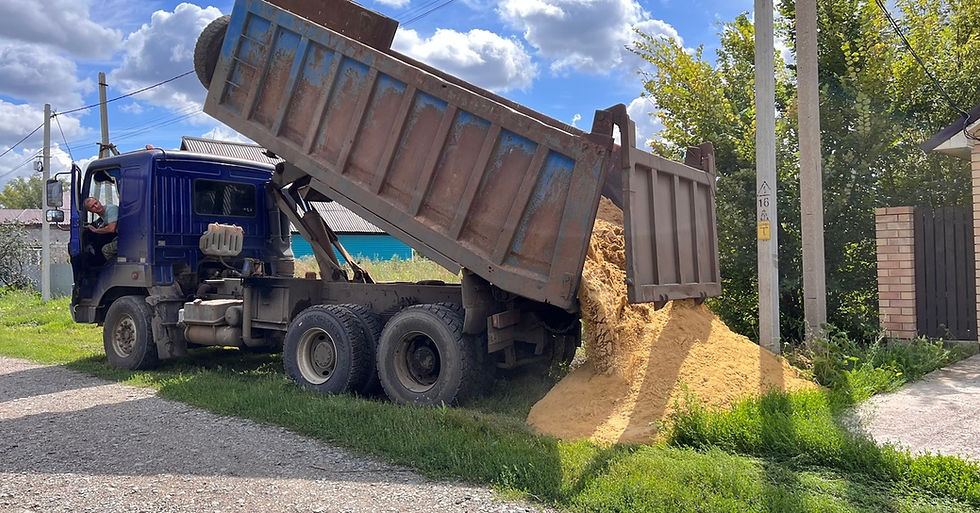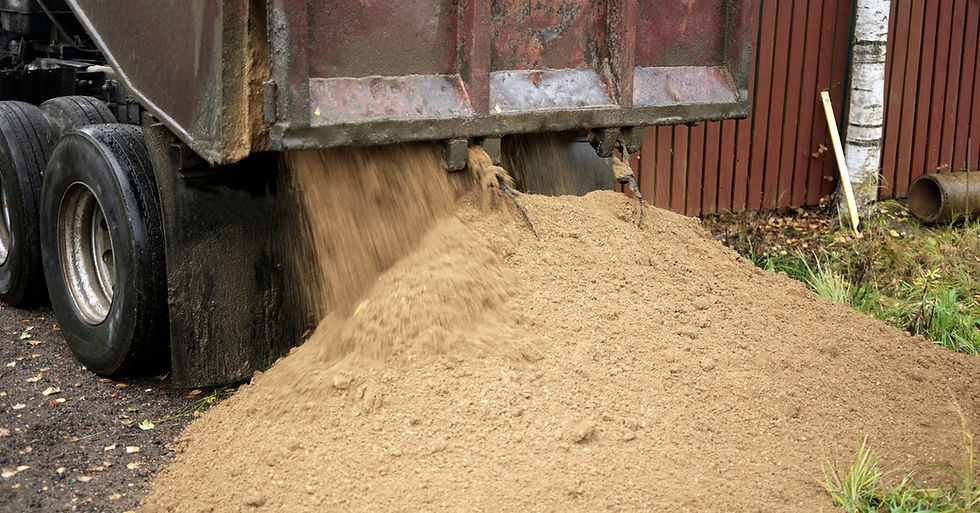What To Expect When Having Sand Delivered at Home
- jthomas701

- Aug 27, 2025
- 4 min read

You’ve got the project planned, the timeline mapped out, and the materials ordered. Now, you’re waiting for one of the most important pieces to show up: the sand. Whether you’re prepping a patio base, filling in low spots of the yard, or tackling a backyard refresh, this part of the process can feel a bit uncertain.
Will the driver call before they show up? Do you need to clear the driveway? What if it’s too steep? And what happens if the load sits there for days?
If you’ve never scheduled this kind of delivery before, it’s natural to wonder what to expect when having sand delivered at home. Let’s walk through what happens next, so you know exactly what to expect when the truck rolls up.
Delivery Timing and Scheduling
Homeowners in Murray, Utah, and surrounding areas can typically expect a quick turnaround. However, supply conditions don’t always cooperate.
When demand is high, sourcing sand can take longer than usual. Even under normal conditions, seasonal slowdowns from November through March can introduce delays. Blizzards or heavy storms can cause deliveries to be paused altogether. To avoid hiccups, place your order at least a week in advance. Doing so gives you the best shot at staying on track.
How Much Is Coming?
Sand orders can vary from one company to another. While some providers require a 15-ton minimum, we at Thomas Sand and Gravel offer more flexibility with a two-ton minimum, ideal for residential projects that don’t need full commercial-scale loads. For reference, one load from us typically carries up to 10 cubic yards. Depending on your project, your order may arrive in a single load or multiple trips.
If you’re not quite sure what two tons of sand looks like—or whether you need more—ask during your call. Instead of guessing, ask for help calculating the right volume based on your project’s square footage and desired depth. The right delivery service will walk you through the math to make sure you’re getting exactly what you need without paying for more than you’ll use.

Where the Sand Gets Dropped
In most cases, sand deliveries are dropped on the street or tree lawn, not on your driveway. Dropping an order on the street reduces the risk of damaging your driveway’s concrete or asphalt surface. Not to mention, it eliminates concerns about weight-related cracking or compaction. And for most homeowners, this curbside drop is the most convenient option because it allows easy access to key areas of their property.
That said, the driver will still need to know exactly where to drop the load. If you have a spot in mind, mark it with cones, a tarp, or painter’s tape so it’s visible. A little preparation can go a long way in avoiding confusion.
If placing the sand on your driveway, you must consider the slope. Steep or sharply inclined surfaces may present safety risks or cause the pile to shift unexpectedly. It’s a good idea to discuss the layout of your property with the delivery team ahead of time.
Truck Access and Limitations
The delivery truck driver needs room to maneuver. Single-axle bobtail trucks can move in tight spaces, which is a major advantage for residential neighborhoods. Still, they require at least eight feet of width and 13 feet of vertical clearance to operate safely.
Bobtail trucks cannot drive across soft lawns, squeeze through narrow gates, or back into backyard areas. If your street is narrow or your driveway is unusually steep, mention these details when placing your order. Planning for these limitations makes for a much smoother delivery day.
What To Do Before Arrival
Before the truck arrives, you can take a few simple steps to make the delivery go smoothly. Start by clearing any cars, trash bins, or other obstructions from the street or driveway. This prevents last-minute repositioning or delays. Consider laying down a tarp or sheet of plywood where the sand can sit. Covering the drop zone keeps the area clean and prevents staining or wash-off during rain.
Keep children and pets indoors during the delivery. Also, trim low-hanging branches or shrubs near the drop site to make it easier for the driver to access the area. You don’t always need to be home for the delivery, but it’s a good idea if you want to walk the driver through placement.

What Happens During Drop-Off
The drop-off process is usually fast; most take less than 5–10 minutes. A call or quick knock on your door may happen before unloading, especially if the designated location isn’t marked. Drivers appreciate simple, visible indicators when space is tight or there’s any uncertainty about where to drop the load.
Some aggregate haulers may offer a printed or handwritten receipt at the time of delivery, while others handle all documentation digitally or beforehand. There may or may not be paperwork to sign on-site, but it’s a good idea to ask about documentation when placing your order so you know what to expect.
After the Sand Is Delivered
Sand deliveries are dumped, not spread. Once the pile is placed, it’s up to you to move it where it needs to go. Try to do this within 24–48 hours to avoid rain compaction, clumping, or neighborhood complaints about windblown dust or blocked walkways.
A square shovel and sturdy wheelbarrow are the best tools. Work in small sections, and pile the sand where needed as you go. If you plan on placing another order down the line, make a quick note of how much was delivered this time. That reference point makes future estimates much easier. And if you’re ordering sand and gravel delivery for a large project, you may want to separate piles with tarps to stay organized.
Deliveries Are Simple If You Know What To Expect
Knowing what to expect when having sand delivered at home can help you avoid surprise delays, unsafe drop zones, or overordering. It’s easy to assume delivery will work like a basic package drop-off, but material delivery is a different kind of coordination.
Too often, homeowners guess at yardage or overlook how their driveway slope might affect the drop. With a little prep and guidance, though, your next sand delivery can be quick, easy, and stress-free.
At Thomas Sand and Gravel, we take the guesswork out of ordering and delivering materials. We’ll help you figure out exactly how much you need, talk through where it can go, and get it to you quickly. When you’re planning a project and want high-quality sand, gravel, or soil delivered by a team that respects your time, give Thomas Sand and Gravel a call.



